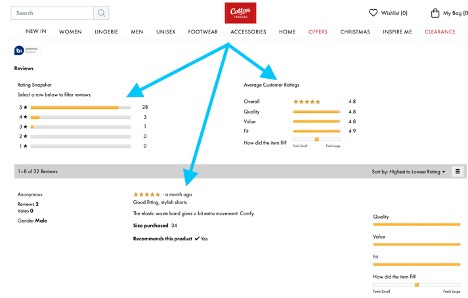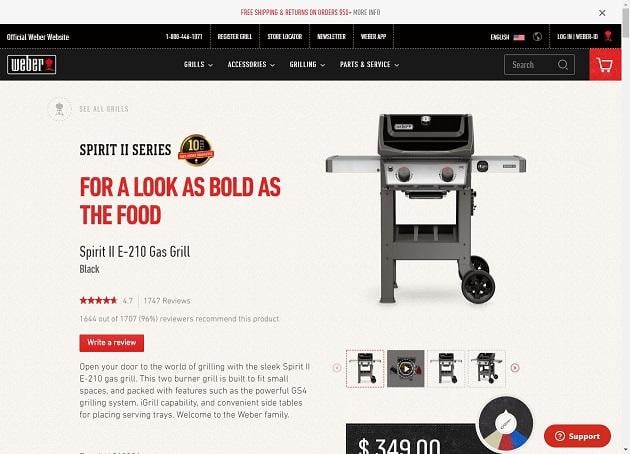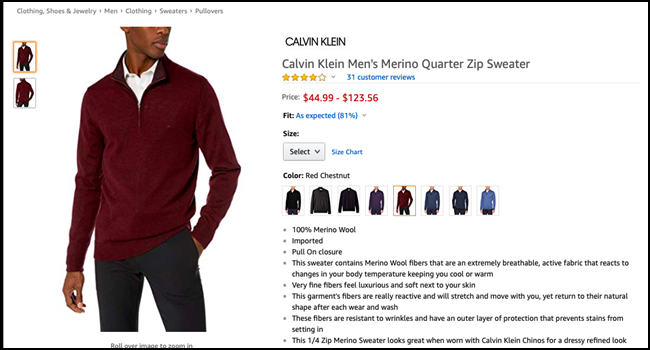Why Product Descriptions Work
A product description is a succinct but informative marketing paragraph that lists the attributes and advantages of a good or service. It serves as a link between prospective buyers and the product.

Throughout history, product descriptions have driven sales. Merchants used descriptive language to highlight their goods in busy marketplaces in ancient civilizations. With the introduction of print media, descriptions gained even more traction. Early product description examples included catalogs and mail-order brochures.
The digital age

Product descriptions are even more important in this digital age. With the growth of e-commerce, many customers now primarily make their purchases through online storefronts. In order to close the gap between a product’s image and a customer’s purchasing decision, e-commerce product descriptions that are both thorough and compelling are essential.
However, what distinguishes an effective product description? The secret is to be able to combine persuasion and information in just the right amounts. A description provides a clear overview of the features, specifications, and functionalities of the product, enabling the customer to make well-informed decisions. Additionally, the description gently prods the buyer to make a purchase by emphasizing the product benefits and how they address a particular issue or need.
Debunking the myth
Taking into account both customer behavior and the function descriptions served in search engine optimization (SEO), it is easy to debunk the myth that nobody reads anything, especially product descriptions. According to statistics from 2017, 87% of buyers consider product content to be “extremely or very important” when making decisions, and 98% have been turned off by inaccurate or incomplete descriptions. These figures demonstrate how important descriptions are for educating and persuading consumers.
Moreover, a product’s visibility in search engine results may suffer from lacking descriptions. Product descriptions play a major role in helping search engines, such as Google, determine what a product is and potentially relevant users. In other words, a well-written description helps the product reach a larger audience through organic search in addition to informing customers.
Don’t underestimate descriptions
Although some customers might quickly scan descriptions, it is incorrect to minimize their significance completely. When making decisions, a sizable percentage of internet shoppers actively look for thorough and educational descriptions. Developing quality product descriptions is still an essential tactic for companies looking to succeed in the cutthroat world of online retail.
Components of a Product Description
A product description is a blend of several essential factors
Headline
The headline is your first impression. It should entice the reader to explore further. It should be concise, and informative, and use keywords that reflect the product’s essence. It should also include unique selling propositions (USPs) or benefits to grab attention.
Body Text
This is the heart of your product description, where you paint a vivid picture of what the product is and how it can benefit the customer. The body text should include:
Benefits

The creative writing adage “show, don’t tell,” applies here. What problem does the product solve? How will it improve the customer’s life? Use benefit-driven language to connect with the customer on an emotional level and demonstrate the value proposition of the product.
Specs and Features
Keep the focus on benefits, also providing some technical specifications. It adds credibility and builds trust. But present technical details in a clear and concise manner. Otherwise you will overwhelm the reader with excessive information.
Social Proof

Including social proof elements like customer testimonials, reviews, or ratings. Positive feedback from past customers builds trust and credibility.
Call to Action
Finally, don’t leave the customer hanging! Conclude your description with a clear call to action (CTA) that encourages them to take the next step. E.g. “add to cart,” “click here,” “contact us,” etc.
How to Write a Good Product Description
A good product description includes information and persuasion. Here’s how you do it:
Know Your Audience
Who are you trying to reach with this product? What are their needs, wants, and pain points? Conduct market research, analyze customer demographics, and consider the specific product category and its typical user base.
Benefits, not Features
While listing features is important, people don’t buy features. They buy the benefits those features provide. E.g., see the difference between “this jacket is waterproof” and “this jacket will keep you dry and comfortable during unexpected downpours.” So focus on how the product solves their problems.
Also include social proof elements like customer testimonials, reviews, or ratings. Go beyond simply displaying star ratings. Feature positive customer quotes that highlight specific product benefits or address common concerns. But don’t fabricate these, especially if you are offering safety, healthcare, or nutrition products.
Strike the Senses

Engage the reader’s senses and create a vivid mental image of the product. Use descriptive language that evokes emotions and paints a picture of the product in use. Consider how this short description appeals to your sight, touch, and sound: “Sleek, minimalist design. Soft, breathable fabric.Crisp, clear audio with powerful bass.”
Be Precise with Words
Aim for clear, concise language that is easy for the reader to understand. Remember, you only have a few seconds to capture their attention, so get straight to the point and highlight the most important information. Keep sentences short and avoid technical jargon. Use active voice and positive language whenever possible.
Also use strong verbs that encourage the reader to take action. For example, when describing a blender, use verbs like “whip up,” “crush,” and “blend.” Or when describing boots, instead of “buy now” try something “explore new trails with our durable boots.”
Use Keywords

A deliberate approach is necessary for using keywords in product descriptions effectively. First, find out which keywords people typically use when searching. Although it’s crucial to include these keywords, don’t use them excessively as this could come off as artificial. Rather, try to naturally scatter them throughout the description, especially in the headings, titles, and URLs. Never forget that you can increase your reach by using synonyms and long-tail keywords, all the while focusing on the intent of the user and how your product helps them. Long-tail keywords are also essential when optimizing your description for voice search. Effective keyword use should ultimately improve user experience rather than worsen it.
Edit Like a Pro
Typos and grammatical errors can stick out like a sore thumb. So take the time to proofread your description carefully. Legendary David Ogilvy said “I am a lousy copywriter, but I am a good editor. So I go to work editing my own draft. After four or five editings, it looks good enough to show to the client.” This shows the importance of editing.
You can use spell-checking tools and grammar checkers, but don’t rely on them. Instead, read aloud to identify awkward phrasing or unclear sentences.
Test and Tweak
Finally, the effectiveness of your product description and making improvements is an iterative process. One method is A/B testing, where you present different versions of the description to random groups of users and compare various metrics. Important metrics to track include click-through rates (CTR), conversion rates (purchase or desired action), time spent on the page, and bounce rates (users leaving the page quickly).
Analyzing these metrics helps identify aspects of the description that resonate with users. Based on this data, you can then tweak the description, focusing on elements that showed promise in the A/B test. This cycle of testing, analyzing, and refining allows you to continuously optimize your product description for improved performance.

Examples of Product Descriptions (and why they work)
Let’s now see some of the best product description examples.
#1 Cookware

This product description for the Weber Spirit II E-210 gas grill uses welcoming language (“Open your door…”) and mentions the grill’s compact size. This specifies the audience: individuals or families with limited space. It also creates a sense of invitation and inclusivity.
While features like the “GS4 grilling system” and “iGrill capability” are mentioned, the description emphasizes the benefit of “powerful grilling” and the convenience of “side tables.” Also notice how they paint a picture with words. The use of “sleek” and “open door” imagery paints a picture of a modern and inviting grilling experience.
Overall, the language is easy to understand and avoids technical jargon. It uses the active voice (“built to fit,” “packed with features”) to keep the tone engaging. Of course, the description can use stronger action verbs related to grilling, such as “sear,” “sizzle,” or “grill to perfection.” Also, there is no social proof.
But overall, the description effectively uses several key strategies to create a positive first impression of the product.
#2 Vehicles

This description for the 2019 Subaru Ascent highlights some key features of good product descriptions. It uses clear and concise language, avoiding technical jargon and making it easy for readers to understand the key features. You can see benefits appealing to families, such as “family-size” with “flexible seating,” “standard Symmetrical All-Wheel Drive” for safety, and “5,000 pounds of towing capacity” for versatility.
They could have also mentioned spacious cargo space or entertainment options for passengers. Moreover, it lacks evocative words like “comfort,” “journey,” or “adventure. However, the visual element (product photos) and technical information make up for these seemingly missing elements.
#3 Apparel

This description for the Calvin Klein Men’s Merino Quarter Zip Sweater outlines several product features. The description uses clear and concise language, listing key features like material, closure, and care information. It also mentions several benefits of the Merino wool, such as breathability, comfort, stretch, and wrinkle resistance.
Why does it work?
Instead of simply listing features like “resistant to wrinkles,” it could explain how this translates into a benefit for the customer, like “minimal ironing needed.” Here we are missing info regarding the target audience to make a clear judgement. Overall, the description provides essential information about the sweater with enough to make customers take action. Social proof is also there, albeit we are not big fans of the star system (alone).
In all these product description examples, don’t forget the visual element. Text alone is not sufficient, but since we are focusing on crafting copy, the use of clear and attractive visuals was not discussed.
Overall, creating a good description involves clarity, i.e. the reader should know exactly what the product is, how it benefits her, and how she can obtain it. Hopefully, these tips will help you write, edit, or review good product copies, and be central to your product experience management strategy.












